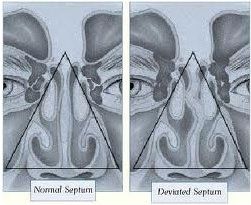The nasal septum is the wall dividing the nasal cavity into halves; it is composed of a central supporting skeleton covered on each side by mucous membrane. The ideal nasal septum is exactly midline, separating the left and right sides of the nose into passageways of equal size.
About 80 % of all nasal septums are off-centre, a condition that is generally not noticed. A “deviated septum” occurs when the septum is severely shifted away from the midline. Septoplasty is the preferred surgical treatment to correct a deviated septum. This procedure is not generally performed on minors, because the cartilaginous septum grows until around age 17.
A deviated nasal septum may cause
- Blockage of one or both nostrils
- Nasal congestion, sometimes one-sided
- Frequent nosebleeds
- Frequent sinus infections
- Facial pain, headaches, postnasal drip
- Noisy breathing during sleep (in infants and young children)
Septoplasty is a surgical procedure performed entirely through the nostrils, accordingly, no bruising or external signs occur. Septoplasty may also be combined with sinus surgery.
The time required for the operation averages about one to one and a half hours, depending on the deviation. It can be done with a local or a general anaesthesia. After the surgery, nasal packing is inserted to prevent excessive postoperative bleeding. During the surgery, badly deviated portions of the septum may be removed entirely, or they may be readjusted and reinserted into the nose.
If a deviated nasal septum is the sole cause for your chronic sinusitis, relief from this severe disorder will be achieved.


